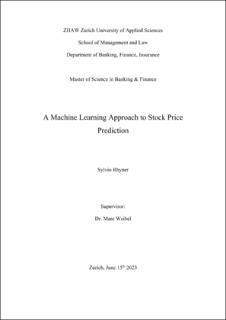Please use this identifier to cite or link to this item:
https://doi.org/10.21256/zhaw-29534Full metadata record
| DC Field | Value | Language |
|---|---|---|
| dc.contributor.advisor | Weibel, Marc | - |
| dc.contributor.author | Rhyner, Sylvio | - |
| dc.date.accessioned | 2024-01-10T15:34:21Z | - |
| dc.date.available | 2024-01-10T15:34:21Z | - |
| dc.date.issued | 2023 | - |
| dc.identifier.uri | https://digitalcollection.zhaw.ch/handle/11475/29534 | - |
| dc.description.abstract | Investing in the stock market is a complex task that relies heavily on the ability to predict future price movements. For decades, investors and financial analysts have sought ways to forecast these trends using a multitude of methodologies, ranging from fundamental to technical analysis. This research implemented a Support Vector Regression (SVR) model, a powerful machine learning technique used for predicting real-valued outputs, to forecast the direction of Dow Jones Industrial Average (DJIA) stocks. The model used several input features, including six technical indicators, to predict future stock prices. The generated predictions were then used to produce trading signals that guided the construction and rebalancing of portfolios. Three different portfolio strategies - weekly, monthly, and quarterly rebalancing - were considered, all of which were compared to a passive equal-weighted (EW) benchmark portfolio. Each strategy relied on the SVR model's trading signals for stock selection, thereby encapsulating a Machine Learning-driven approach to investment management. The weekly rebalancing strategy emerged as the top performer across multiple metrics, including net cumulative return, annualized return, and the Sharpe ratio, thus outperforming the monthly, quarterly, and even the EW benchmark portfolio. This illustrates the potential benefits of frequent portfolio rebalancing in optimizing returns, despite the associated transaction costs. The results also show the influence of major global events, such as the Global Financial Crisis and the COVID-19 pandemic, as well as the rate of transaction costs on the portfolio performance. Future research should be directed towards the optimization of time windows for technical indicators and the weights of selected stocks. | de_CH |
| dc.format.extent | 55 | de_CH |
| dc.language.iso | en | de_CH |
| dc.publisher | ZHAW Zürcher Hochschule für Angewandte Wissenschaften | de_CH |
| dc.rights | http://creativecommons.org/licenses/by-nc-nd/4.0/ | de_CH |
| dc.subject.ddc | 006: Spezielle Computerverfahren | de_CH |
| dc.subject.ddc | 332.6: Investition | de_CH |
| dc.title | A machine learning approach to stock price prediction | de_CH |
| dc.type | Thesis: Master | de_CH |
| dcterms.type | Text | de_CH |
| zhaw.departement | School of Management and Law | de_CH |
| zhaw.publisher.place | Winterthur | de_CH |
| dc.identifier.doi | 10.21256/zhaw-29534 | - |
| zhaw.originated.zhaw | Yes | de_CH |
| Appears in collections: | MSc Banking and Finance | |
Files in This Item:
| File | Description | Size | Format | |
|---|---|---|---|---|
| 2023_Rhyner_Sylvio_MSc_BF.pdf | 1.03 MB | Adobe PDF |  View/Open |
Show simple item record
Rhyner, S. (2023). A machine learning approach to stock price prediction [Master’s thesis, ZHAW Zürcher Hochschule für Angewandte Wissenschaften]. https://doi.org/10.21256/zhaw-29534
Rhyner, S. (2023) A machine learning approach to stock price prediction. Master’s thesis. ZHAW Zürcher Hochschule für Angewandte Wissenschaften. Available at: https://doi.org/10.21256/zhaw-29534.
S. Rhyner, “A machine learning approach to stock price prediction,” Master’s thesis, ZHAW Zürcher Hochschule für Angewandte Wissenschaften, Winterthur, 2023. doi: 10.21256/zhaw-29534.
RHYNER, Sylvio, 2023. A machine learning approach to stock price prediction. Master’s thesis. Winterthur: ZHAW Zürcher Hochschule für Angewandte Wissenschaften
Rhyner, Sylvio. 2023. “A Machine Learning Approach to Stock Price Prediction.” Master’s thesis, Winterthur: ZHAW Zürcher Hochschule für Angewandte Wissenschaften. https://doi.org/10.21256/zhaw-29534.
Rhyner, Sylvio. A Machine Learning Approach to Stock Price Prediction. ZHAW Zürcher Hochschule für Angewandte Wissenschaften, 2023, https://doi.org/10.21256/zhaw-29534.
Items in DSpace are protected by copyright, with all rights reserved, unless otherwise indicated.